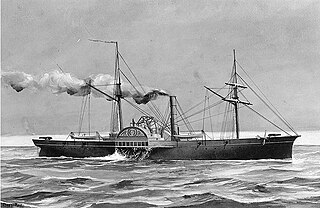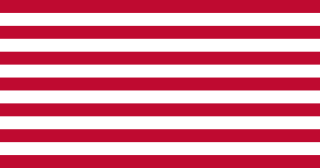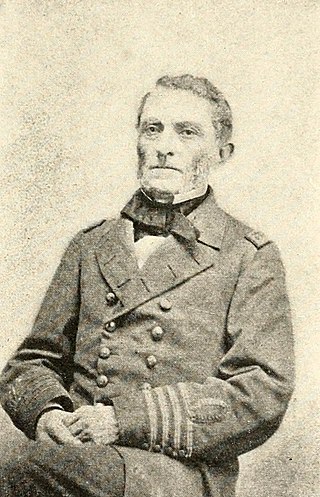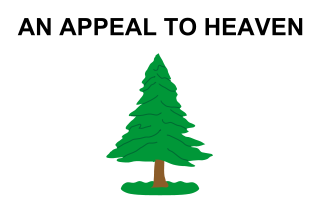
The Norfolk Naval Shipyard, often called the Norfolk Navy Yard and abbreviated as NNSY, is a U.S. Navy facility in Portsmouth, Virginia, for building, remodeling and repairing the Navy's ships. It is the oldest and largest industrial facility that belongs to the U.S. Navy as well as the most comprehensive. Located on the Elizabeth River, the yard is just a short distance upriver from its mouth at Hampton Roads.

CSS Patrick Henry was a ship built in New York City in 1859 by the renowned William H. Webb for the Old Dominion Steam Ship Line as the civilian steamer Yorktown, a brigantine-rigged side-wheel steamer. She carried passengers and freight between Richmond, Virginia and New York City. Yorktown was anchored in the James River when Virginia seceded from the Union on 17 April 1861 and was seized by the Virginia Navy and later turned over to the Confederate Navy on 8 June 1861.

The Battle of Hampton Roads, also referred to as the Battle of the Monitor and Merrimack or the Battle of Ironclads, was a naval battle during the American Civil War.

The Confederate States Navy (CSN) was the naval branch of the Confederate States Armed Forces, established by an act of the Confederate States Congress on February 21, 1861. It was responsible for Confederate naval operations during the American Civil War against the United States's Union Navy.

The Continental Navy was the navy of the Thirteen Colonies during the American Revolutionary War. Founded on October 13, 1775, the fleet developed into a relatively substantial force throughout the Revolutionary War, owing partially to the substantial efforts of the Continental Navy's patrons within the Continental Congress. These Congressional Patrons included the likes of John Adams, who served as the Chairman of the Naval Committee until 1776, when Commodore Esek Hopkins received instruction from the Continental Congress to assume command of the force.

CSS Manassas, formerly the steam icebreaker Enoch Train, was built in 1855 by James O. Curtis as a twin-screw towboat at Medford, Massachusetts. A New Orleans commission merchant, Captain John A. Stevenson, acquired her for use as a privateer after she was captured by another privateer CSS Ivy. Her fitting out as Manassas was completed at Algiers, Louisiana; her conversion to a ram of a radically modern design made her the first ironclad ship built for the Confederacy.

CSS Jamestown, originally a side-wheel, passenger steamer, was built at New York City in 1853, and seized at Richmond, Virginia in 1861 for the Virginia Navy during the early days of the American Civil War. She was commissioned by the Confederate States Navy (CSN) the following July, and renamed CSS Thomas Jefferson but was generally referred to as Jamestown, after Jamestown, Virginia.

A South Carolina Navy has been formed twice by the State of South Carolina. The first time was during the American Revolutionary War, in which the state purchased and outfitted armed vessels independent of the Continental Navy. The second time was during the American Civil War, when its navy was also distinct from the Confederate States Navy.

Commodore Garrett Jesse Pendergrast was an officer in the United States Navy, who served at the beginning of the American Civil War.

The Pennsylvania Navy served as the naval force of Pennsylvania during the American Revolution and afterward, until the formation of the United States Navy. The navy's vessels served almost exclusively on the Delaware River, and were active in first defending the approaches to the city of Philadelphia during the British campaign that successfully occupied the city in 1777, and then preventing the Royal Navy from resupplying the occupying army.

Samuel Barron was a United States, and later Confederate naval officer, acting as a representative in Europe for the Confederacy during the American Civil War.
The James River Squadron was formed shortly after the secession of Virginia during the American Civil War. The squadron was part of the Virginia Navy before being transferred to the Confederate States Navy. The squadron is most notable for its role in patrolling the James River, which was the main water approach to the Confederate capital, Richmond. It had two phases: early war, when it consisted mostly of wooden ships which ended with the Battle of Drewry's Bluff on May 15, 1862; and its later ironclad composition with the flagship CSS Virginia II.

The Massachusetts Naval Militia, was a naval militia active during the American Revolutionary War. It was founded December 29, 1775, to defend the interests of Massachusetts during the war.

The history of Hampton Roads dates to 1607, when Jamestown was founded. Two wars have taken place in addition to many other historical events.

The historical battles of Lexington and Concord in Massachusetts sparked the beginning of the American War for Independence on 19 April 1775; soon after, the rest of the thirteen American colonies were pulled into the conflict. Many of the leaders in the rebellion recognized that a naval engagement against the British was the primary option to prevent the British from restoring Crown rule by military occupation.

The North Carolina State Navy during the American Revolutionary War consisted of a relatively modest number of ships, and was active from 1776 to 1779. The state and the Continental Congress were concerned about the defense of Pamlico Sound, and the key Ocracoke Inlet, through which a large number of inbound merchant ships traveled, bringing war-related supplies from Europe and the West Indies.

CSS Ivy was a sidewheel steamer and privateer purchased by Commodore Lawrence Rousseau for service with the Confederate States Navy, and chosen by Commodore George Hollins for his Mosquito Fleet. The Mosquito Fleet was a group of riverboats converted to gunboats, and used to defend the Mississippi River in the area of New Orleans during the American Civil War.
Andrew Sprowle was a Scottish-born merchant, naval agent, landowner, shipyard owner, slaveholder and slave trader in Portsmouth, Virginia. Today Andrew Sprowle is best remembered for establishing the Gosport Ship Yard, now known as Norfolk Naval Shipyard. Sprowle emigrated from Milton, West Dunbartonshire, Scotland to what is currently the Commonwealth of Virginia in the mid-18th century, where he lived until his death on 29 May 1776.














